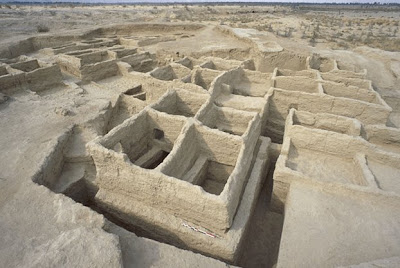FROM 7th Mill. BC
These houses were builyt by Mehgarh dwellers c. 8000 years BC
by C. Jarrige
Here follows an account of Mehrgarh by pioneer French archeologist who explored the area from time to time, and was first to excavate the Mehrgarh site. Let us now see what does world’s top most researcher on Mehrgarh say about the archeological excavations at Mehrgarh — a breakthrough that bestows a totally singular position to Indus Valley Civilisation — the first civilized, urban settlement on face of this earth.
In the fourth millennium and in the first half of the third, the Mehrgarh potters and those from other parts of Balochistan alike became known for producing very high quality ceramics which were either exported or copied in eastern Iran, southern Afghanistan, and even as far as present-day Tadjikistan, notably at the Sarazm site. These periods are also distinguished by the manufacture of human figurines of a high aesthetic quality, whose attributes seem to suggest references to an underlying mythology still unclear to us.
Nausharo
The Nausharo excavation, 6 km from Mehrgarh as the crow flies, revealed a dwelling-site contemporaneous and identical to the Mehrgarh, one between 3000 and 2500 BC and another, divided into three periods between 2500 and 1900 BC, characteristic of the urban civilization of the valley of the Indus, which is also referred to as the Harappan civilization, from the name of the eponymous site of Harappa. This excavation of Nausharo allows the Indus civilisation to be linked to the cultures which preceded it since the Neolithic and the ancient Chalcolithic times. The excavation of the Harappan layers led to the uncovering of a settlement which met the criteria of the urban civilization of the Indus, with discrete rectangular zones, and with the existence of baths and hydraulic features. The study of Harappan ceramics in Naushara has brought to light a clear stylistic evolution over time, thus contradicting the theories claiming that Harappan pottery had remained static for several centuries.
Starting from a period of about 2100 BC, which corresponds to phase-IV of Nausharo, ceramics and other objects begin to appear in the Bolan basin which are comparable to those from sites in Afghanistan, Turkmenistan, Uzbekistan and the east of Iran. Some of these objects had been found previously, notably on the upper levels of the great civilization sites of the Indus, such as Mohenjo-daro and Chanhu-daro. It had been thought that these were in fact remains which indicated the arrival of invaders from the West and from the North-West. Thanks to the Nausharo dig and to the discovery of necropolises (the Mehrgarh VIII cemetery) and of various sites on the edge of Nausharo or Mehrgarh, it is now clear that the “exotic” objects belong to groups who have co-existed with the “Harappan” populations, evidently peaceably. It can even be asserted that all these objects are an indication of the development of very important trading activities whose agents between the Indus valley and Mesopotamia were groups who controlled the routes for inter-Iranian exchanges around 2000 BC.
Pirak
Between 1800 and 1900 BC, the urban civilization of the Indus disappeared to survive, in derivative forms, only in the territory of present-day India. The excavation of Pirak, a settlement of about ten hectares inhabited between 1800 and 600 BC, reveals the beginning of a new age. Several miniatures of horsemen and horses and of two-humped camels – animals unknown in the Indus civilization – symbolize important changes in society. The emergence of horsemen at Pirak, just like the discovery of horse skeletons at the time in the Swat in the north of Pakistan, is to be considered in the context of the arrival of new populations belonging, perhaps, to the very first Indo-Aryan groups mixing with a local community with an increasingly diversified agricultural economy. It has been noted that in fact the cultivation of rice, which demands the use of irrigation techniques, became predominant.
As for the structures where the interior walls are punctuated with rows of symmetrical marks, sometimes on four levels: these represent a style which was still found a few years ago in houses, particularly in Hindu areas, in this region. About 1200 BC, iron utensils and weapons would emerge.
Since the end of the expedition in 2000 to the Neolithic part of the Mehrgarh site, fieldwork has been halted to allow for deeper analysis of date and to write up publications. In 2003 there was an expedition to study the material at Mehrgarh, and the dig was scheduled to resume in 2004.
Concluded.
Courtesy: Guimet.com


No comments:
Post a Comment